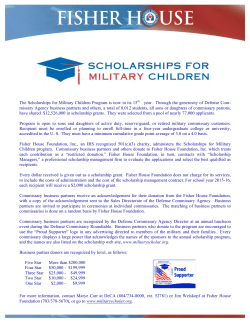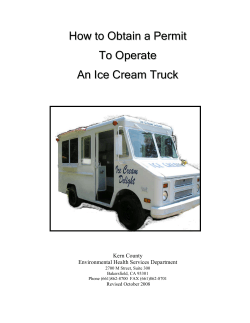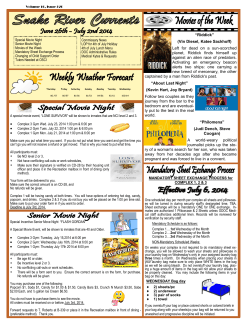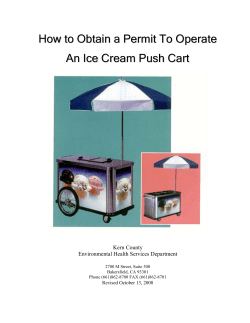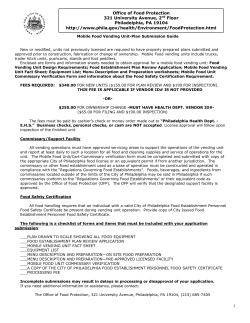
Document 168428
Whitman County Public Health Environmental Health Division N. 310 Main Street Colfax, WA 99111 Phone:509.397.6280 FAX: 509.397.6239 Mobile Food Service Operation Plan Review and Operation Guidelines Mobile Food Carts Restricted & Unrestricted Mobile Food Units FRESH FOOD MOBILE FOOD SERVICE PLAN REVIEW GUIDELINES I. DEFINITIONS AND PERMIT CLASSIFICATIONS FROM THE FOOD CODE: Mobile food service unit. “Mobile food service unit” means an approved movable vehicle or cart that is operated from either a fixed location or on an established daily route; is supplied from, and cleaned, maintained and stored at, a commissary or base of operation; and from which food is prepared, served, or provided for the public with or without charge. Such units shall be classified according to the following categories: II. A. “Mobile Food Cart” – A cart limited to serving non-potentially hazardous foods with no preparation except microwave warming for immediate service, hot dogs, espresso beverages, snow cones or limited non-potentially hazardous beverages. B. “Restricted Mobile Food Vehicle” – A vehicle limited to serving only prepackaged potentially hazardous foods requiring no further food preparation except microwave warming for immediate service. C. “Unrestricted Mobile Food Vehicle” – A vehicle preparing or serving food that is not packaged. GENERAL INFORMATION Mobile food service units are not movable restaurants. Because facilities are extremely limited, food preparation is restricted. Not all foods are suitable for mobile food service. All requirements are based on the menu and preparation procedures on the mobile food service unit. A definite menu must be set. Design requirements of the mobile unit vary with the type of food (hazardous or nonhazardous) and whether the food is pre-packaged or not. All mobile food service units are evaluated on an individual basis. All new operations require complete mobile plan review regardless of whether the unit has been issued a previous permit. The plan review fee is $175.00 for the first two hours of plan review; each additional hour will be billed at a rate of $75.00 per hour. Information necessary for plan review includes: 1) ownership information, 2) menu, 3) design of the mobile food service unit, 4) commissary, and/or base of operation, 5) site location/itinerary and 6) operating procedures. Your plans must conclude with the following statement: “NO CHANGES MAY BE MADE WITHOUT PRIOR HEALTH DEPARTMENT APPROVAL” This includes any changes in ownership, menu, location, itinerary, hours of operation, commissary, etc. Changes must be submitted to the plan reviewer for approval. A single change will be cost of service/hour. Multiple changes require submission of a new plan and additional plan review fees of $175.00 for the first 2 hours and $75 for each additional hour after. All regulations of WAC 246-215-160 must be followed by owners and employees of mobile food units. For questions or comments, please contact: Whitman County Public Health Environmental Health Division N. 310 Main Street Colfax, WA 99111 Phone (509) 397-6280 Fax (509) 397-6239 III. PLAN REVIEW REQUIREMENTS A. Ownership Information – List name and the location of the mobile food service, please include information for the owner’s name, home address and phone number. B. Menu – List all food and beverages to be served. Include whether foods are packaged or how foods are dispensed. Prepackaged foods are preferred and in a restricted mobile food unit, may be required. Some foods are exempt from code, such as commercially prepared and prepackaged non-potentially hazardous foods. Please remember, after a mobile plan is approved any menu changes will require Health Department approval. Outline food preparation procedures according to your menu. Note all steps in the preparation of each menu item; please include information on condiments, preparation at the commissary or preparation on the vehicle when applicable. All food items used or sold must be from an approved source. Use of food prepared in unapproved kitchens or living quarters is not allowed. C. Design of Cart/Vehicle – Basic design is entirely up to the owner. A scale drawing, including all views is required (top view, front view, side view, elevation). In the drawing, please include all equipment on cart/vehicle, such as temperature control equipment, plumbing fixtures, tanks, water heater, etc. If available, include spec sheets for equipment. Note surface finish on plan – all surfaces must be smooth, sealed, durable and easy to clean. Use of liquid propane gas may require Fire Department approval and permit. Contact the Fire Department in the area you plan to operate in. 1. Carts: In Whitman County, on public property, cart body size is limited to 3 feet by 5 feet with each extension no longer than 18 inches. The cart should be easily movable by one person. All food, equipment, utensils, paper products, water tanks and cleaning supplies must be stored on the cart or in the commissary. No additional storage is allowed beside the cart except for an ice chest. The ice chest may be used for non-potentially hazardous foods only. A waste container must be provided for refuse generated by the cart operation. 2. Occupied Vehicles: All occupied vehicles based in Washington State (commercial coaches) must obtain approval from Washington State Department of Labor and Industries (L&I). L&I’s rules and regulations govern the safety of body and frame design and the installation of plumbing, heating and electrical equipment. Contact the L & I Plans Examiner at (360) 902-5799 in Olympia for your packet of information on L & I plan review. Obtain L & I’s inspection and seal of approval prior to your plan review by Whitman County Public Health Department (black label affixed to the outside of the vehicle). D. Commissary – The commissary, or base of operations, is an essential part of a mobile unit’s operation. The mobile unit must be serviced daily at a commissary. The commissary must be under permit by Whitman County Health Department, or a facility approved by the health authority. Even if the commissary is already a licensed facility, plans for the commissary must accompany the mobile plan for review. All facilities and operations must meet requirements of the Food Code. A copy of the commissary plan must be included in the mobile plans. To be approved a commissary must have: 1. The commissary requirements must all be at one location, not the sinks in one place and storage at another 2. A three-compartment sink. 3. Floors, walls, and ceilings that are smooth, non-absorbent, durable, and easily cleaned. 4. Approved facility to service clean water and waste water tanks. Wastewater must be disposed of into a sanitary sewage disposal system. 5. The commissary must provide adequate storage for all supplies, including refrigeration if required. 6. The commissary must be separated from any living quarters and shall not be used for any purpose other than servicing approved mobile food service establishments. 7. A conveniently located restroom equipped with toilet, hand sink, soap dispenser, single use towels, and a covered trash can. E. Site Location/Itinerary – Mobile carts must have an exact location for their operation. A site map must show the cart location in relationship to streets, buildings, etc. Also, show the distance from the site location to the commissary. Any change in location must be approved by the Health Department. Provide a letter of restroom availability giving permission for employees to use a public restroom within 200 feet during the business hours of the cart. The distance is the usual route a person would take to reach the restroom. Mobile vehicles operation at a specific location follows the same requirements as above for carts. Mobile vehicles who have a daily route must submit an itinerary of their locations, specifying exact locations and times, hours of operation, and when the vehicle /employee will be back at the commissary. Mobile vehicles must provide letters of restroom availability for every two (2) hours on the road. Updated itineraries must be provided to your Health Department District for approval when itineraries change. F. IV. Operating Procedures – Note business hours and time at the commissary. Submit an outline of your daily activities. Start with preloading of the unit, transport to site location, set-up on site, your operation during business hours, continuous cleaning and sanitizing procedures while operating, etc. For the end of the business day, outline closing procedures for unit, transport back to commissary, unloading of cart, storage of supplies (i.e., food, paper products, utensils), cleaning and sanitizing procedures, maintenance of water and waste water tanks, and cart storage. SPECIFIC REQUIREMENTS BY MOBILE FOOD SERVICE CLASSIFICATIONS: A. Mobile Food Cart. Carts are limited to serving only espresso, beverages and non-potentially hazardous foods with limited food preparation; i.e., fresh squeezed high acid juices, or snow cones. No preparation of potentially hazardous food is allowed on a mobile cart. 1. Food Preparation and Maintenance a. All employees must possess a valid Food and beverage Establishment Worker Permit. b. All preparation and packaging of non-potentially hazardous foods must be done at the commissary or another commercial establishment. Proper food preparation procedures and adequate facilities must be used. c. Hot dogs must meet the definition of hot dogs, and must be cooked to and hot held at 140 F or above. All warmed hot dogs left over at the end of the day must be discarded. d. Milk for espresso must be steamed for immediate service only, and then the pitcher placed in the refrigerator until the next order. Leftover steamed milk at the end of the day must be discarded. e. Granita machines must maintain temperatures of 45o F or less. The machines must be cleaned and sanitized daily. f. Juice preparation is limited to high acid juices, such as lemonade. Extractors and blenders are not allowed on carts because of the difficulty of cleaning them during operation. g. Mechanical refrigeration is required for milk and hot dogs. Temperatures must be kept at 45 F or less. Thermometers must be visible in all refrigeration units. h. A metal stem type thermometer must be available to check food temperatures. i. Microwave ovens are allowed for reheating of non-potentially hazardous foods for immediate service only. j. Sanitized wiping cloths are required. Clean wiping cloths and sanitizing solution must be on location. Soiled wiping cloths must be stored in a separate plastic bag. All work surfaces must be sanitized throughout the day. k. Reusable utensils (i.e., tongs, spoons, etc.) must be washed and sanitized at the commissary every two (2) hours. If the commissary is not convenient to carry out constant dish washing, then extra clean and sanitized utensils must be loaded on the cart with soiled utensils being replaced approximately every two hours. Store dirty utensils in a separate container for washing and sanitizing at the commissary. l. No utensils are needed for prepackaged foods. The operator cannot package or handle unwrapped food. Only the customer can open the package. m. Customer utensils must be single service and stored and dispensed in a sanitary manner. n. Condiments must be prepackaged single servings or in dispenser bottles. 2. Sinks and water supply requirements for carts preparing or serving unwrapped foods. a. A handsink is required, with hot and cold or tempered running water (minimum 80 f, maximum 120 F), under pressure, with handsoap and paper towels. The handsink must be operational and easily accessible at all times while the cart is in operation. If handsinks are in cabinets or drawers, they must be left open to keep the handsink available. A minimum of 5 gallons of water is required for handwashing. Any additional water for use on the cart must be provided in addition to the water for handwashing. b. Water supply for the handsink must be from an approved source (i.e., approved public water supply at commissary). c. The waste water tank must be 15% larger than the fresh water supply tank. d. Tanks for water supply must be made of food-grade materials. Tanks for water supply and waste water shall be rigid, durable and cleanable. Collapsible tanks are not acceptable. Tanks must be easily cleanable. e. The waste water tank must be emptied or drained at the commissary, or approved disposal site, NEVER on the street or ground or used to water plants. If waste tanks are not removable, a drainage pad, graded and sewered, is required, as well as facilities for in-place cleaning and sanitizing. f. The outlet for the waste water must be located lower than the clean water intake. g. The waste water and clean water tank must be serviced daily at the permitted commissary. B. Restricted Mobile Food Vehicle. A vehicle or person serving prepackaged food and beverages pursuant to prearranged itineraries (specific routes) or at a fixed location. Peddling in residential areas may be prohibited in certain municipalities. Please check with the local City Hall on any restrictions. 1. All employees must possess a valid Food and beverage Establishment Worker Permit. 2. All preparation and packaging must be done at the commissary or another commercial establishment. Proper food preparation procedures and adequate facilities must be used. Potentially hazardous foods must be at 45o F or less or 140o F or above while on the truck. 3. Mechanical refrigeration is preferred and may be required depending on menu (i.e., hazardous foods and length of business day). Refreezable or dry ice may be utilized in an ice chest, the inside and outside must be smooth, cleanable and durable. (Styrofoam ice chests are not approved). 4. Facilities for hot holding must maintain 140 F or above. Mechanical units are required, powered by propane, electricity or generators, etc. Thermostatic controls are recommended to adequately control hot holding temperature in variable weather conditions. 5. Facilities for reheating must rapidly reheat within one hour. Hot holding of reheated foods is not recommended. Reheating “to order” is a safer method and may be required. Potentially hazardous foods prepared in the commissary may be reheated for immediate service only. 6. Thermometers must be available in all cold holding units. A metal stem type thermometer must be available to check food temperatures for hot and cold foods. 7. No utensils are needed for prepackaged foods. The operator cannot open packages or handle unwrapped food. Only the customer can open the package. 8. Customer utensils must be single service and stored and dispensed in a sanitary manner. 9. Condiments must be prepackaged single servings or in dispenser bottles C. Unrestricted Mobile Food Vehicle. An unrestricted mobile food vehicle is a vehicle preparing or serving food in an approved enclosed mobile unit which operates at a specified location or on a prearranged route. The vehicle may serve non-potentially hazardous foods or may do limited preparation of potentially hazardous foods. Limited preparation allows for simplified food preparation and reduces the number of steps where food may become contaminated (i.e., quick “cook and serve” or “assemble and serve” on order). 1. All employees must possess a valid Food and beverage Establishment Worker Permit. 2. All preparation and packaging must be done in the commissary or another commercial establishment; i.e., chopping lettuce, cutting tomatoes, slicing meat, making soup. Minimal food preparation is allowed on the vehicle, there may also be additional requirements. 3. Mechanical refrigeration is required for all potentially hazardous foods. Cold potentially hazardous foods must be held less than 45 F. 4. Facilities for hot holding must maintain 140 F or above. Mechanical units are required, powered by propane, electricity, or generators. 5. Cooking of raw meats on the vehicle is restricted to thin foods, such as, hamburger patties. Cooking of raw meats greater than one inch thick in thickness is not allowed. 6. Facilities for reheating must rapidly reheat within one hour. Hot holding of reheated foods is not recommended. Reheating “to order” is a safer method and may be required. Potentially hazardous foods prepared in the commissary may be reheated for immediate service only. 7. All foods on the vehicle must be protected from contamination such as with sneeze guards, or dome shields. 8. Condiments must be in single service packages or dispenser bottles. Condiments unavailable in single service packaging and which can’t be dispensed in bottles may be served in bulk, provided that the condiment is non-potentially hazardous and there is a sneeze guard for food protection. 9. Customer utensils must be single service and stored and dispensed in a sanitary manner. 10. Thermometers must be available in all cold holding units. A metal stem type thermometer is required to check all food temperatures (hot and cold). 11. Sanitized wiping cloths are required. Clean wiping cloths and a sanitizing solution must be on the vehicle. Soiled wiping cloths must be stored in a separate plastic bag. 12. All equipment and supplies must be stored on the mobile vehicle or in the commissary. 13. A handsink used for washing hands only is required. 14. Ventilation hoods are required for any grease producing cooking equipment. If deep fryers are utilized, a tight fitting, heat resistant cover shall be locked in place for safe transport of hot grease. 15. If water tanks are refilled by hoses, the hoses must be food grade, retractable to facilitate sanitary storage off the ground and used for no other purpose than for freshwater draw. All hoses must have vacuum breakers to prevent back siphonage. Hose connections to tanks must be tight and must quickly connect/release. A mop sink must still be provided at the commissary for vehicle clean up.
© Copyright 2025

